Managing Ethical Scandals in Commonwealth Bank of Australia: A Public Relations Perspective
VerifiedAdded on 2023/06/10
|13
|4011
|251
AI Summary
This article discusses the ethical scandals faced by Commonwealth Bank of Australia, its impact on the bank's image, stakeholders' analysis, existence barriers, and the role of PR in crisis management. It also provides recommendations to enhance its CSR.
Contribute Materials
Your contribution can guide someone’s learning journey. Share your
documents today.
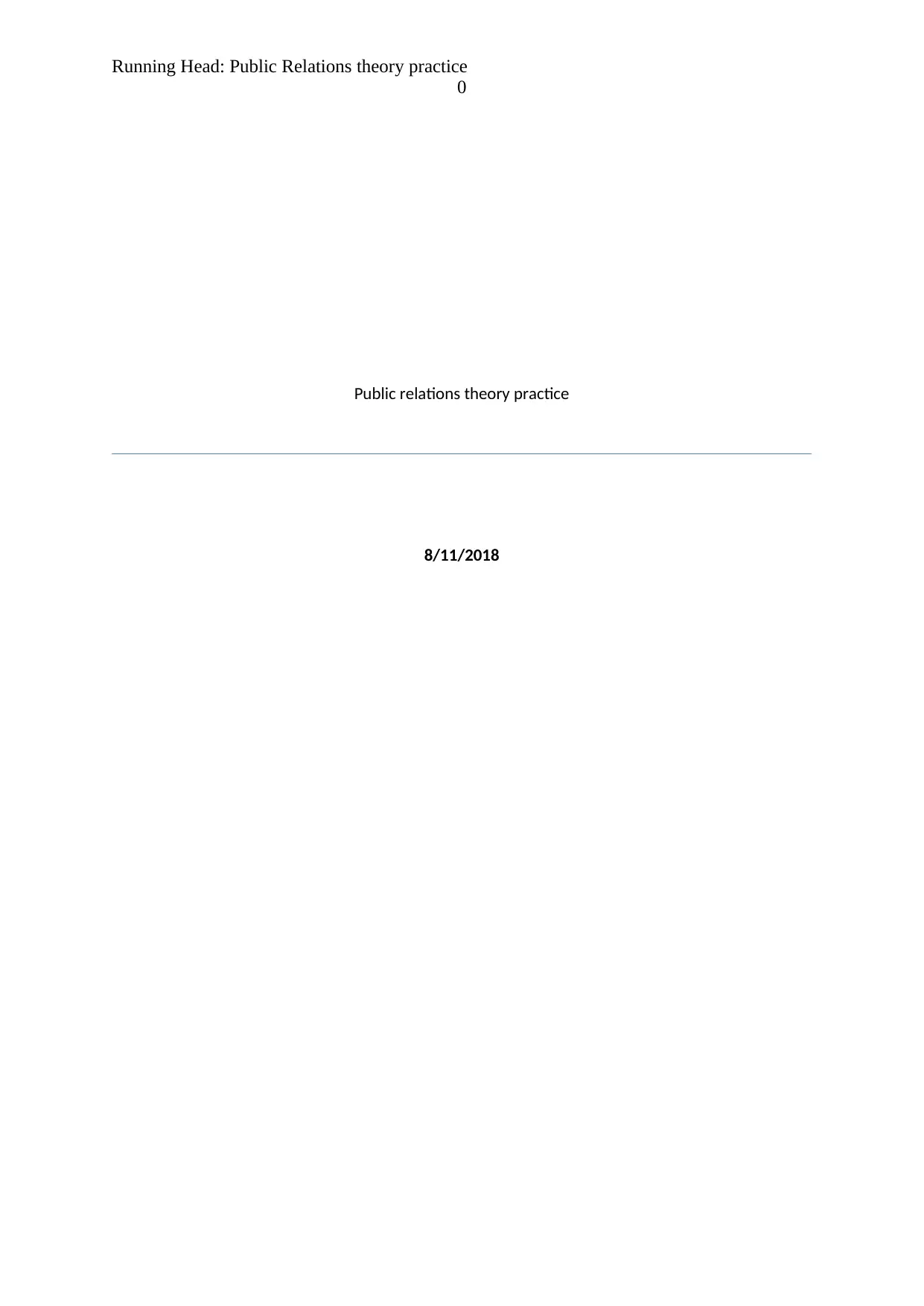
Running Head: Public Relations theory practice
0
Public relations theory practice
8/11/2018
0
Public relations theory practice
8/11/2018
Secure Best Marks with AI Grader
Need help grading? Try our AI Grader for instant feedback on your assignments.
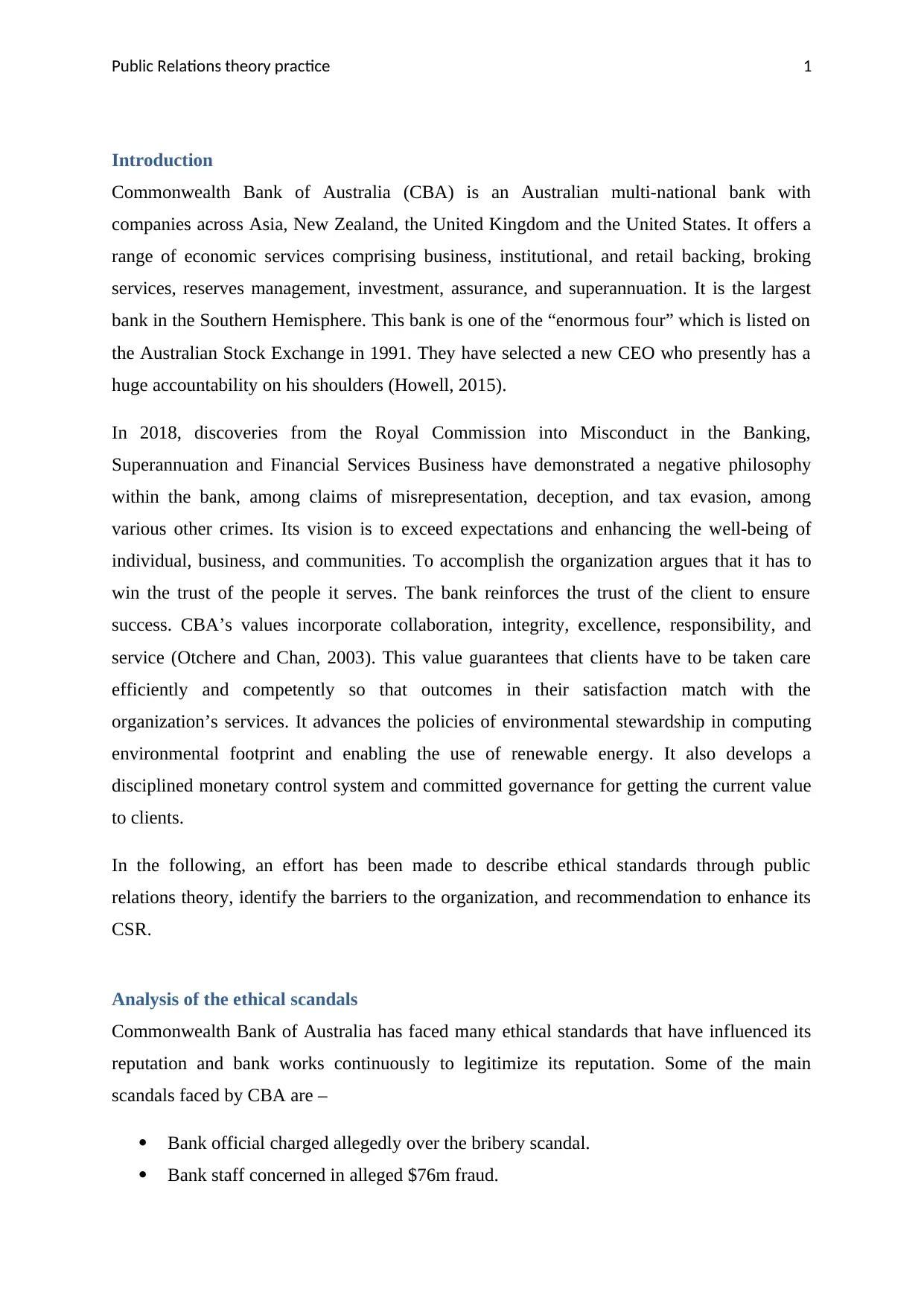
Public Relations theory practice 1
Introduction
Commonwealth Bank of Australia (CBA) is an Australian multi-national bank with
companies across Asia, New Zealand, the United Kingdom and the United States. It offers a
range of economic services comprising business, institutional, and retail backing, broking
services, reserves management, investment, assurance, and superannuation. It is the largest
bank in the Southern Hemisphere. This bank is one of the “enormous four” which is listed on
the Australian Stock Exchange in 1991. They have selected a new CEO who presently has a
huge accountability on his shoulders (Howell, 2015).
In 2018, discoveries from the Royal Commission into Misconduct in the Banking,
Superannuation and Financial Services Business have demonstrated a negative philosophy
within the bank, among claims of misrepresentation, deception, and tax evasion, among
various other crimes. Its vision is to exceed expectations and enhancing the well-being of
individual, business, and communities. To accomplish the organization argues that it has to
win the trust of the people it serves. The bank reinforces the trust of the client to ensure
success. CBA’s values incorporate collaboration, integrity, excellence, responsibility, and
service (Otchere and Chan, 2003). This value guarantees that clients have to be taken care
efficiently and competently so that outcomes in their satisfaction match with the
organization’s services. It advances the policies of environmental stewardship in computing
environmental footprint and enabling the use of renewable energy. It also develops a
disciplined monetary control system and committed governance for getting the current value
to clients.
In the following, an effort has been made to describe ethical standards through public
relations theory, identify the barriers to the organization, and recommendation to enhance its
CSR.
Analysis of the ethical scandals
Commonwealth Bank of Australia has faced many ethical standards that have influenced its
reputation and bank works continuously to legitimize its reputation. Some of the main
scandals faced by CBA are –
Bank official charged allegedly over the bribery scandal.
Bank staff concerned in alleged $76m fraud.
Introduction
Commonwealth Bank of Australia (CBA) is an Australian multi-national bank with
companies across Asia, New Zealand, the United Kingdom and the United States. It offers a
range of economic services comprising business, institutional, and retail backing, broking
services, reserves management, investment, assurance, and superannuation. It is the largest
bank in the Southern Hemisphere. This bank is one of the “enormous four” which is listed on
the Australian Stock Exchange in 1991. They have selected a new CEO who presently has a
huge accountability on his shoulders (Howell, 2015).
In 2018, discoveries from the Royal Commission into Misconduct in the Banking,
Superannuation and Financial Services Business have demonstrated a negative philosophy
within the bank, among claims of misrepresentation, deception, and tax evasion, among
various other crimes. Its vision is to exceed expectations and enhancing the well-being of
individual, business, and communities. To accomplish the organization argues that it has to
win the trust of the people it serves. The bank reinforces the trust of the client to ensure
success. CBA’s values incorporate collaboration, integrity, excellence, responsibility, and
service (Otchere and Chan, 2003). This value guarantees that clients have to be taken care
efficiently and competently so that outcomes in their satisfaction match with the
organization’s services. It advances the policies of environmental stewardship in computing
environmental footprint and enabling the use of renewable energy. It also develops a
disciplined monetary control system and committed governance for getting the current value
to clients.
In the following, an effort has been made to describe ethical standards through public
relations theory, identify the barriers to the organization, and recommendation to enhance its
CSR.
Analysis of the ethical scandals
Commonwealth Bank of Australia has faced many ethical standards that have influenced its
reputation and bank works continuously to legitimize its reputation. Some of the main
scandals faced by CBA are –
Bank official charged allegedly over the bribery scandal.
Bank staff concerned in alleged $76m fraud.
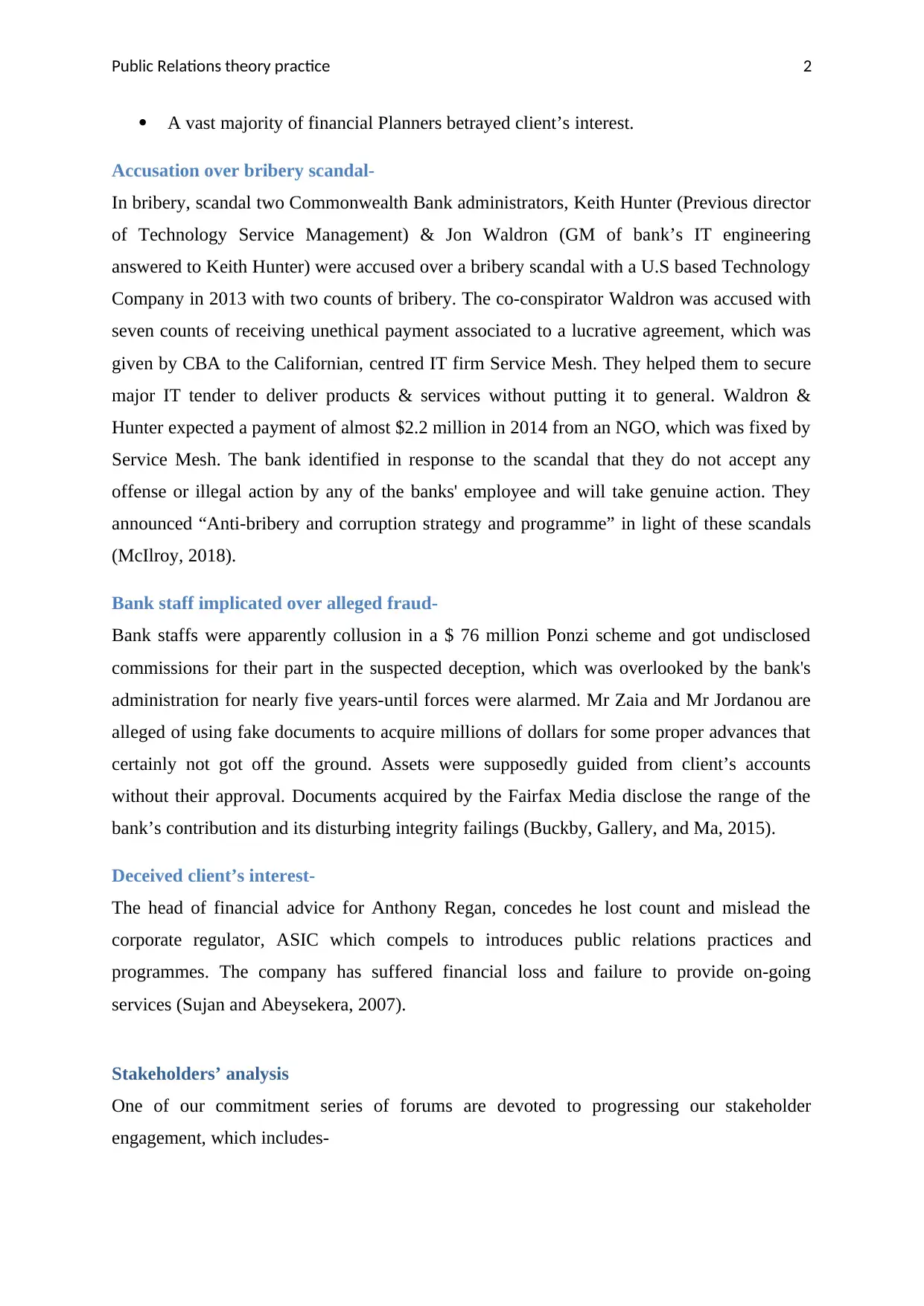
Public Relations theory practice 2
A vast majority of financial Planners betrayed client’s interest.
Accusation over bribery scandal-
In bribery, scandal two Commonwealth Bank administrators, Keith Hunter (Previous director
of Technology Service Management) & Jon Waldron (GM of bank’s IT engineering
answered to Keith Hunter) were accused over a bribery scandal with a U.S based Technology
Company in 2013 with two counts of bribery. The co-conspirator Waldron was accused with
seven counts of receiving unethical payment associated to a lucrative agreement, which was
given by CBA to the Californian, centred IT firm Service Mesh. They helped them to secure
major IT tender to deliver products & services without putting it to general. Waldron &
Hunter expected a payment of almost $2.2 million in 2014 from an NGO, which was fixed by
Service Mesh. The bank identified in response to the scandal that they do not accept any
offense or illegal action by any of the banks' employee and will take genuine action. They
announced “Anti-bribery and corruption strategy and programme” in light of these scandals
(McIlroy, 2018).
Bank staff implicated over alleged fraud-
Bank staffs were apparently collusion in a $ 76 million Ponzi scheme and got undisclosed
commissions for their part in the suspected deception, which was overlooked by the bank's
administration for nearly five years-until forces were alarmed. Mr Zaia and Mr Jordanou are
alleged of using fake documents to acquire millions of dollars for some proper advances that
certainly not got off the ground. Assets were supposedly guided from client’s accounts
without their approval. Documents acquired by the Fairfax Media disclose the range of the
bank’s contribution and its disturbing integrity failings (Buckby, Gallery, and Ma, 2015).
Deceived client’s interest-
The head of financial advice for Anthony Regan, concedes he lost count and mislead the
corporate regulator, ASIC which compels to introduces public relations practices and
programmes. The company has suffered financial loss and failure to provide on-going
services (Sujan and Abeysekera, 2007).
Stakeholders’ analysis
One of our commitment series of forums are devoted to progressing our stakeholder
engagement, which includes-
A vast majority of financial Planners betrayed client’s interest.
Accusation over bribery scandal-
In bribery, scandal two Commonwealth Bank administrators, Keith Hunter (Previous director
of Technology Service Management) & Jon Waldron (GM of bank’s IT engineering
answered to Keith Hunter) were accused over a bribery scandal with a U.S based Technology
Company in 2013 with two counts of bribery. The co-conspirator Waldron was accused with
seven counts of receiving unethical payment associated to a lucrative agreement, which was
given by CBA to the Californian, centred IT firm Service Mesh. They helped them to secure
major IT tender to deliver products & services without putting it to general. Waldron &
Hunter expected a payment of almost $2.2 million in 2014 from an NGO, which was fixed by
Service Mesh. The bank identified in response to the scandal that they do not accept any
offense or illegal action by any of the banks' employee and will take genuine action. They
announced “Anti-bribery and corruption strategy and programme” in light of these scandals
(McIlroy, 2018).
Bank staff implicated over alleged fraud-
Bank staffs were apparently collusion in a $ 76 million Ponzi scheme and got undisclosed
commissions for their part in the suspected deception, which was overlooked by the bank's
administration for nearly five years-until forces were alarmed. Mr Zaia and Mr Jordanou are
alleged of using fake documents to acquire millions of dollars for some proper advances that
certainly not got off the ground. Assets were supposedly guided from client’s accounts
without their approval. Documents acquired by the Fairfax Media disclose the range of the
bank’s contribution and its disturbing integrity failings (Buckby, Gallery, and Ma, 2015).
Deceived client’s interest-
The head of financial advice for Anthony Regan, concedes he lost count and mislead the
corporate regulator, ASIC which compels to introduces public relations practices and
programmes. The company has suffered financial loss and failure to provide on-going
services (Sujan and Abeysekera, 2007).
Stakeholders’ analysis
One of our commitment series of forums are devoted to progressing our stakeholder
engagement, which includes-
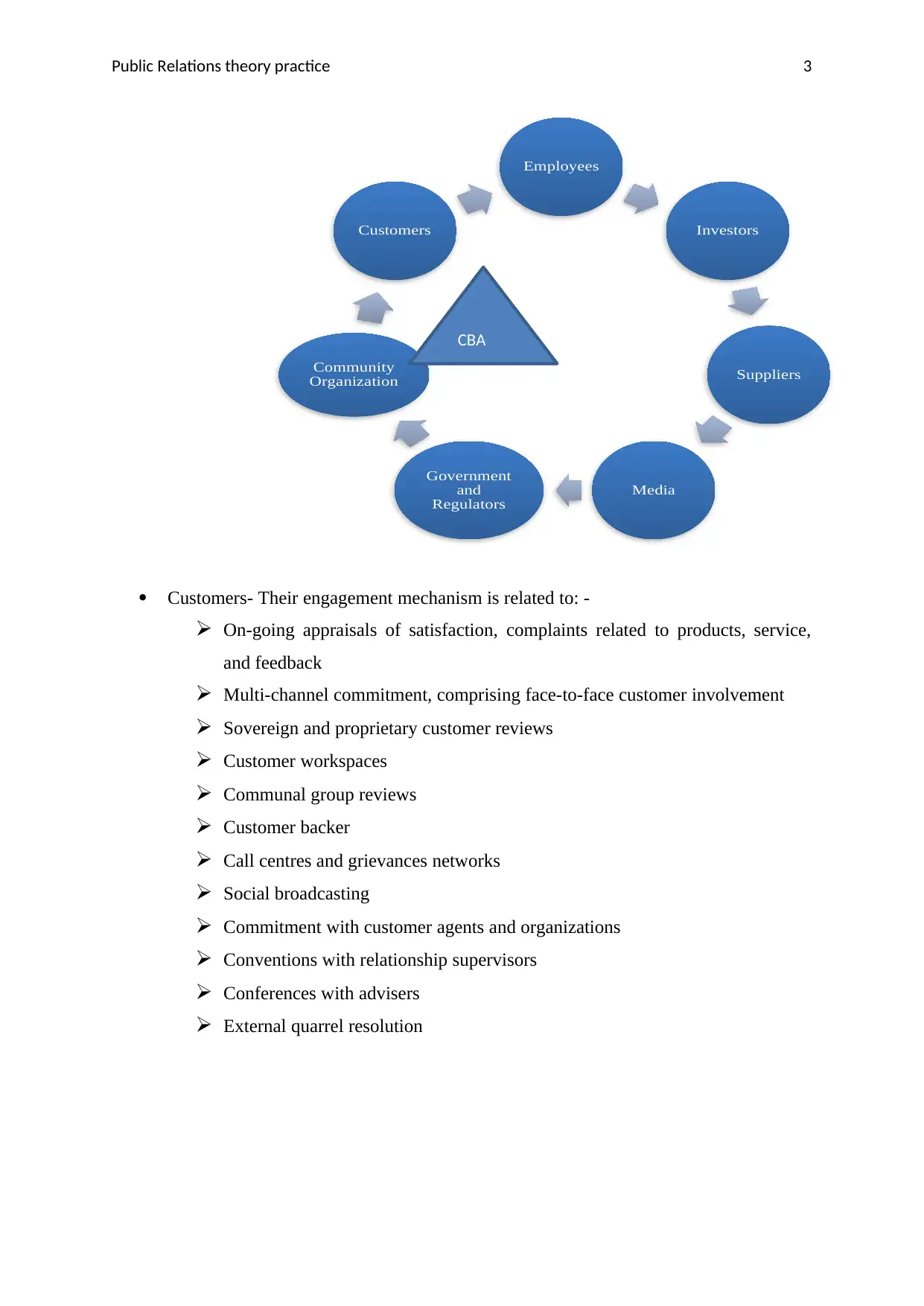
Public Relations theory practice 3
Customers- Their engagement mechanism is related to: -
On-going appraisals of satisfaction, complaints related to products, service,
and feedback
Multi-channel commitment, comprising face-to-face customer involvement
Sovereign and proprietary customer reviews
Customer workspaces
Communal group reviews
Customer backer
Call centres and grievances networks
Social broadcasting
Commitment with customer agents and organizations
Conventions with relationship supervisors
Conferences with advisers
External quarrel resolution
Employees
Investors
Suppliers
Media
Government
and
Regulators
Community
Organization
Customers
CBA
Customers- Their engagement mechanism is related to: -
On-going appraisals of satisfaction, complaints related to products, service,
and feedback
Multi-channel commitment, comprising face-to-face customer involvement
Sovereign and proprietary customer reviews
Customer workspaces
Communal group reviews
Customer backer
Call centres and grievances networks
Social broadcasting
Commitment with customer agents and organizations
Conventions with relationship supervisors
Conferences with advisers
External quarrel resolution
Employees
Investors
Suppliers
Media
Government
and
Regulators
Community
Organization
Customers
CBA
Secure Best Marks with AI Grader
Need help grading? Try our AI Grader for instant feedback on your assignments.
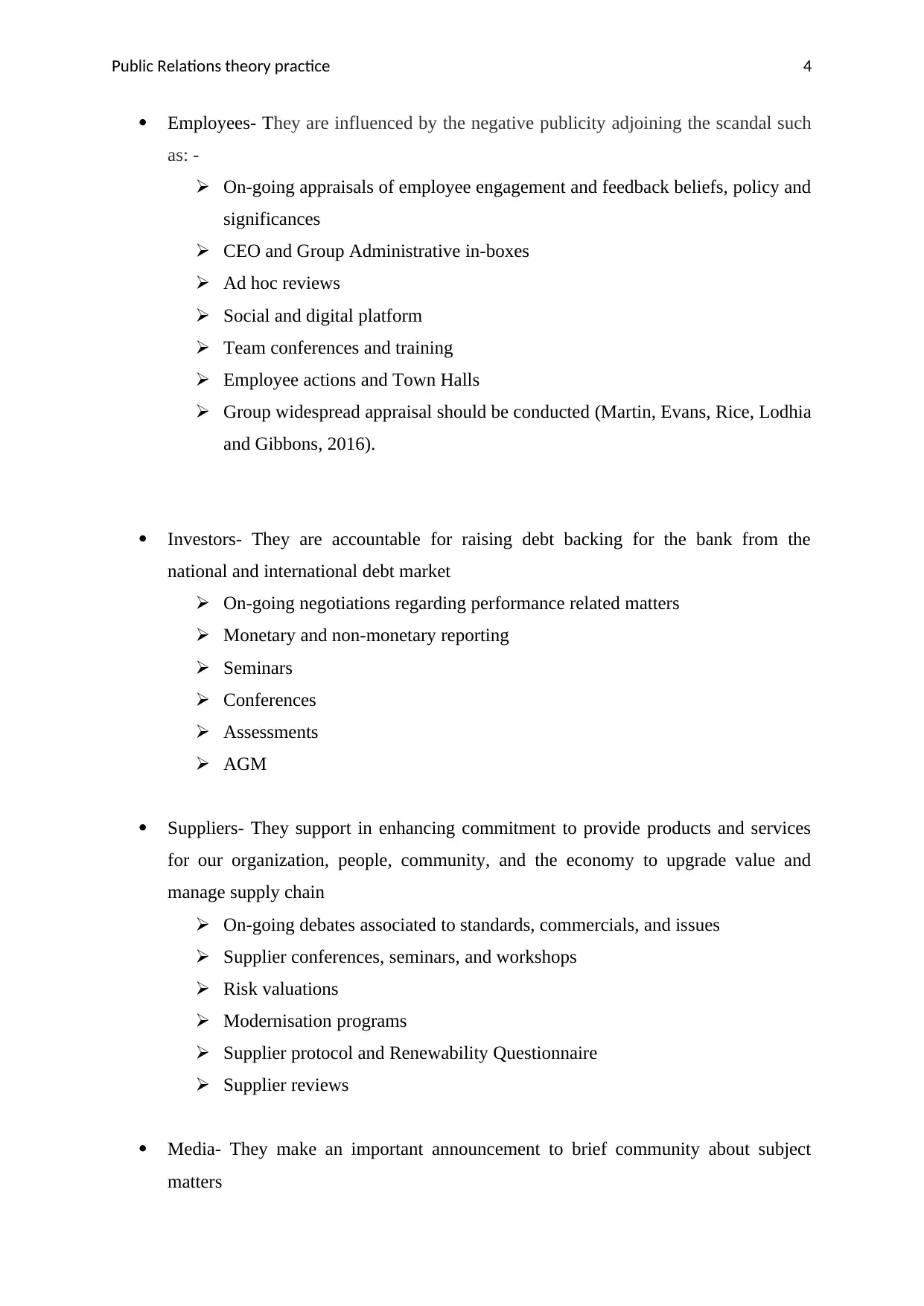
Public Relations theory practice 4
Employees- They are influenced by the negative publicity adjoining the scandal such
as: -
On-going appraisals of employee engagement and feedback beliefs, policy and
significances
CEO and Group Administrative in-boxes
Ad hoc reviews
Social and digital platform
Team conferences and training
Employee actions and Town Halls
Group widespread appraisal should be conducted (Martin, Evans, Rice, Lodhia
and Gibbons, 2016).
Investors- They are accountable for raising debt backing for the bank from the
national and international debt market
On-going negotiations regarding performance related matters
Monetary and non-monetary reporting
Seminars
Conferences
Assessments
AGM
Suppliers- They support in enhancing commitment to provide products and services
for our organization, people, community, and the economy to upgrade value and
manage supply chain
On-going debates associated to standards, commercials, and issues
Supplier conferences, seminars, and workshops
Risk valuations
Modernisation programs
Supplier protocol and Renewability Questionnaire
Supplier reviews
Media- They make an important announcement to brief community about subject
matters
Employees- They are influenced by the negative publicity adjoining the scandal such
as: -
On-going appraisals of employee engagement and feedback beliefs, policy and
significances
CEO and Group Administrative in-boxes
Ad hoc reviews
Social and digital platform
Team conferences and training
Employee actions and Town Halls
Group widespread appraisal should be conducted (Martin, Evans, Rice, Lodhia
and Gibbons, 2016).
Investors- They are accountable for raising debt backing for the bank from the
national and international debt market
On-going negotiations regarding performance related matters
Monetary and non-monetary reporting
Seminars
Conferences
Assessments
AGM
Suppliers- They support in enhancing commitment to provide products and services
for our organization, people, community, and the economy to upgrade value and
manage supply chain
On-going debates associated to standards, commercials, and issues
Supplier conferences, seminars, and workshops
Risk valuations
Modernisation programs
Supplier protocol and Renewability Questionnaire
Supplier reviews
Media- They make an important announcement to brief community about subject
matters
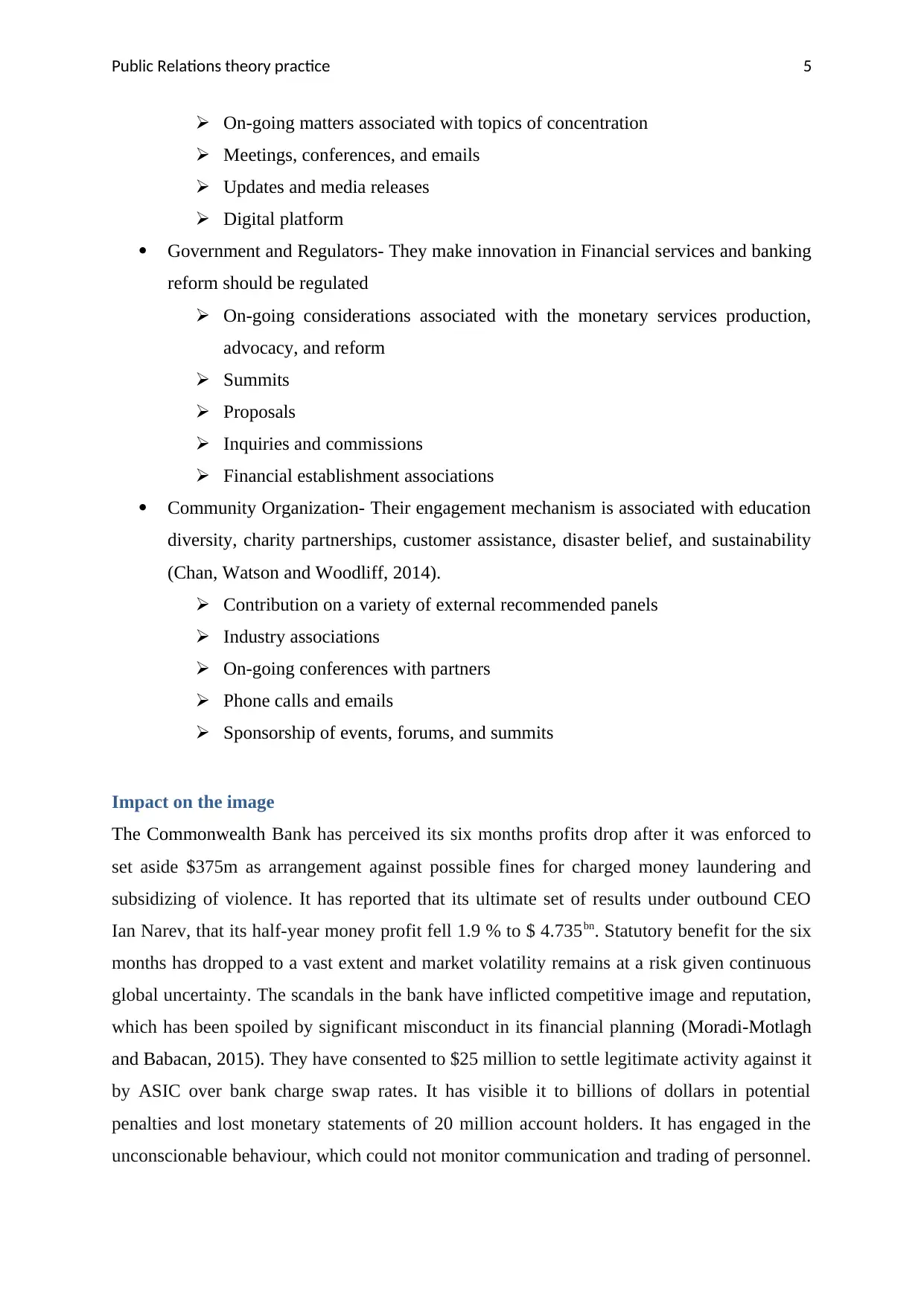
Public Relations theory practice 5
On-going matters associated with topics of concentration
Meetings, conferences, and emails
Updates and media releases
Digital platform
Government and Regulators- They make innovation in Financial services and banking
reform should be regulated
On-going considerations associated with the monetary services production,
advocacy, and reform
Summits
Proposals
Inquiries and commissions
Financial establishment associations
Community Organization- Their engagement mechanism is associated with education
diversity, charity partnerships, customer assistance, disaster belief, and sustainability
(Chan, Watson and Woodliff, 2014).
Contribution on a variety of external recommended panels
Industry associations
On-going conferences with partners
Phone calls and emails
Sponsorship of events, forums, and summits
Impact on the image
The Commonwealth Bank has perceived its six months profits drop after it was enforced to
set aside $375m as arrangement against possible fines for charged money laundering and
subsidizing of violence. It has reported that its ultimate set of results under outbound CEO
Ian Narev, that its half-year money profit fell 1.9 % to $ 4.735bn. Statutory benefit for the six
months has dropped to a vast extent and market volatility remains at a risk given continuous
global uncertainty. The scandals in the bank have inflicted competitive image and reputation,
which has been spoiled by significant misconduct in its financial planning (Moradi-Motlagh
and Babacan, 2015). They have consented to $25 million to settle legitimate activity against it
by ASIC over bank charge swap rates. It has visible it to billions of dollars in potential
penalties and lost monetary statements of 20 million account holders. It has engaged in the
unconscionable behaviour, which could not monitor communication and trading of personnel.
On-going matters associated with topics of concentration
Meetings, conferences, and emails
Updates and media releases
Digital platform
Government and Regulators- They make innovation in Financial services and banking
reform should be regulated
On-going considerations associated with the monetary services production,
advocacy, and reform
Summits
Proposals
Inquiries and commissions
Financial establishment associations
Community Organization- Their engagement mechanism is associated with education
diversity, charity partnerships, customer assistance, disaster belief, and sustainability
(Chan, Watson and Woodliff, 2014).
Contribution on a variety of external recommended panels
Industry associations
On-going conferences with partners
Phone calls and emails
Sponsorship of events, forums, and summits
Impact on the image
The Commonwealth Bank has perceived its six months profits drop after it was enforced to
set aside $375m as arrangement against possible fines for charged money laundering and
subsidizing of violence. It has reported that its ultimate set of results under outbound CEO
Ian Narev, that its half-year money profit fell 1.9 % to $ 4.735bn. Statutory benefit for the six
months has dropped to a vast extent and market volatility remains at a risk given continuous
global uncertainty. The scandals in the bank have inflicted competitive image and reputation,
which has been spoiled by significant misconduct in its financial planning (Moradi-Motlagh
and Babacan, 2015). They have consented to $25 million to settle legitimate activity against it
by ASIC over bank charge swap rates. It has visible it to billions of dollars in potential
penalties and lost monetary statements of 20 million account holders. It has engaged in the
unconscionable behaviour, which could not monitor communication and trading of personnel.
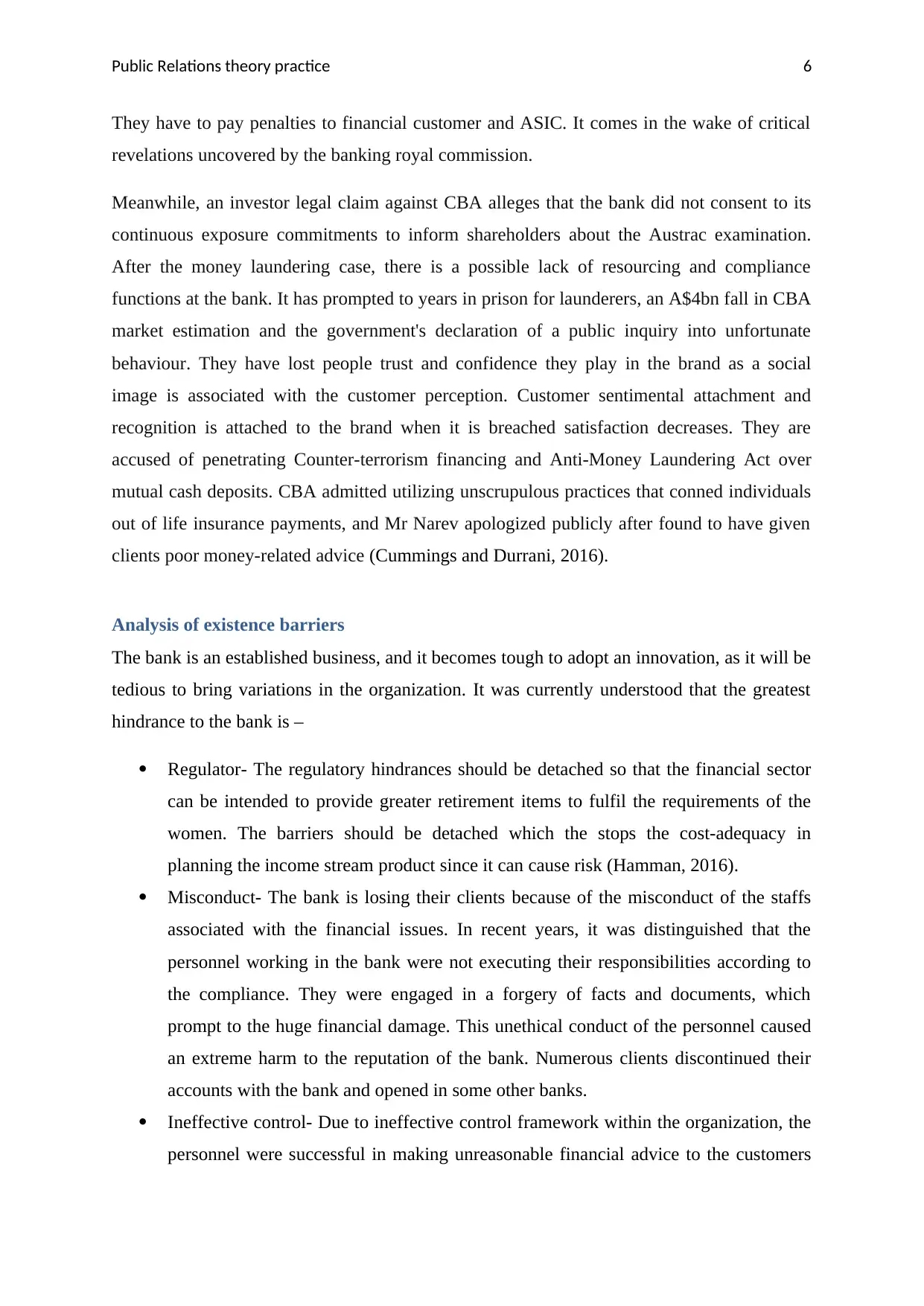
Public Relations theory practice 6
They have to pay penalties to financial customer and ASIC. It comes in the wake of critical
revelations uncovered by the banking royal commission.
Meanwhile, an investor legal claim against CBA alleges that the bank did not consent to its
continuous exposure commitments to inform shareholders about the Austrac examination.
After the money laundering case, there is a possible lack of resourcing and compliance
functions at the bank. It has prompted to years in prison for launderers, an A$4bn fall in CBA
market estimation and the government's declaration of a public inquiry into unfortunate
behaviour. They have lost people trust and confidence they play in the brand as a social
image is associated with the customer perception. Customer sentimental attachment and
recognition is attached to the brand when it is breached satisfaction decreases. They are
accused of penetrating Counter-terrorism financing and Anti-Money Laundering Act over
mutual cash deposits. CBA admitted utilizing unscrupulous practices that conned individuals
out of life insurance payments, and Mr Narev apologized publicly after found to have given
clients poor money-related advice (Cummings and Durrani, 2016).
Analysis of existence barriers
The bank is an established business, and it becomes tough to adopt an innovation, as it will be
tedious to bring variations in the organization. It was currently understood that the greatest
hindrance to the bank is –
Regulator- The regulatory hindrances should be detached so that the financial sector
can be intended to provide greater retirement items to fulfil the requirements of the
women. The barriers should be detached which the stops the cost-adequacy in
planning the income stream product since it can cause risk (Hamman, 2016).
Misconduct- The bank is losing their clients because of the misconduct of the staffs
associated with the financial issues. In recent years, it was distinguished that the
personnel working in the bank were not executing their responsibilities according to
the compliance. They were engaged in a forgery of facts and documents, which
prompt to the huge financial damage. This unethical conduct of the personnel caused
an extreme harm to the reputation of the bank. Numerous clients discontinued their
accounts with the bank and opened in some other banks.
Ineffective control- Due to ineffective control framework within the organization, the
personnel were successful in making unreasonable financial advice to the customers
They have to pay penalties to financial customer and ASIC. It comes in the wake of critical
revelations uncovered by the banking royal commission.
Meanwhile, an investor legal claim against CBA alleges that the bank did not consent to its
continuous exposure commitments to inform shareholders about the Austrac examination.
After the money laundering case, there is a possible lack of resourcing and compliance
functions at the bank. It has prompted to years in prison for launderers, an A$4bn fall in CBA
market estimation and the government's declaration of a public inquiry into unfortunate
behaviour. They have lost people trust and confidence they play in the brand as a social
image is associated with the customer perception. Customer sentimental attachment and
recognition is attached to the brand when it is breached satisfaction decreases. They are
accused of penetrating Counter-terrorism financing and Anti-Money Laundering Act over
mutual cash deposits. CBA admitted utilizing unscrupulous practices that conned individuals
out of life insurance payments, and Mr Narev apologized publicly after found to have given
clients poor money-related advice (Cummings and Durrani, 2016).
Analysis of existence barriers
The bank is an established business, and it becomes tough to adopt an innovation, as it will be
tedious to bring variations in the organization. It was currently understood that the greatest
hindrance to the bank is –
Regulator- The regulatory hindrances should be detached so that the financial sector
can be intended to provide greater retirement items to fulfil the requirements of the
women. The barriers should be detached which the stops the cost-adequacy in
planning the income stream product since it can cause risk (Hamman, 2016).
Misconduct- The bank is losing their clients because of the misconduct of the staffs
associated with the financial issues. In recent years, it was distinguished that the
personnel working in the bank were not executing their responsibilities according to
the compliance. They were engaged in a forgery of facts and documents, which
prompt to the huge financial damage. This unethical conduct of the personnel caused
an extreme harm to the reputation of the bank. Numerous clients discontinued their
accounts with the bank and opened in some other banks.
Ineffective control- Due to ineffective control framework within the organization, the
personnel were successful in making unreasonable financial advice to the customers
Paraphrase This Document
Need a fresh take? Get an instant paraphrase of this document with our AI Paraphraser
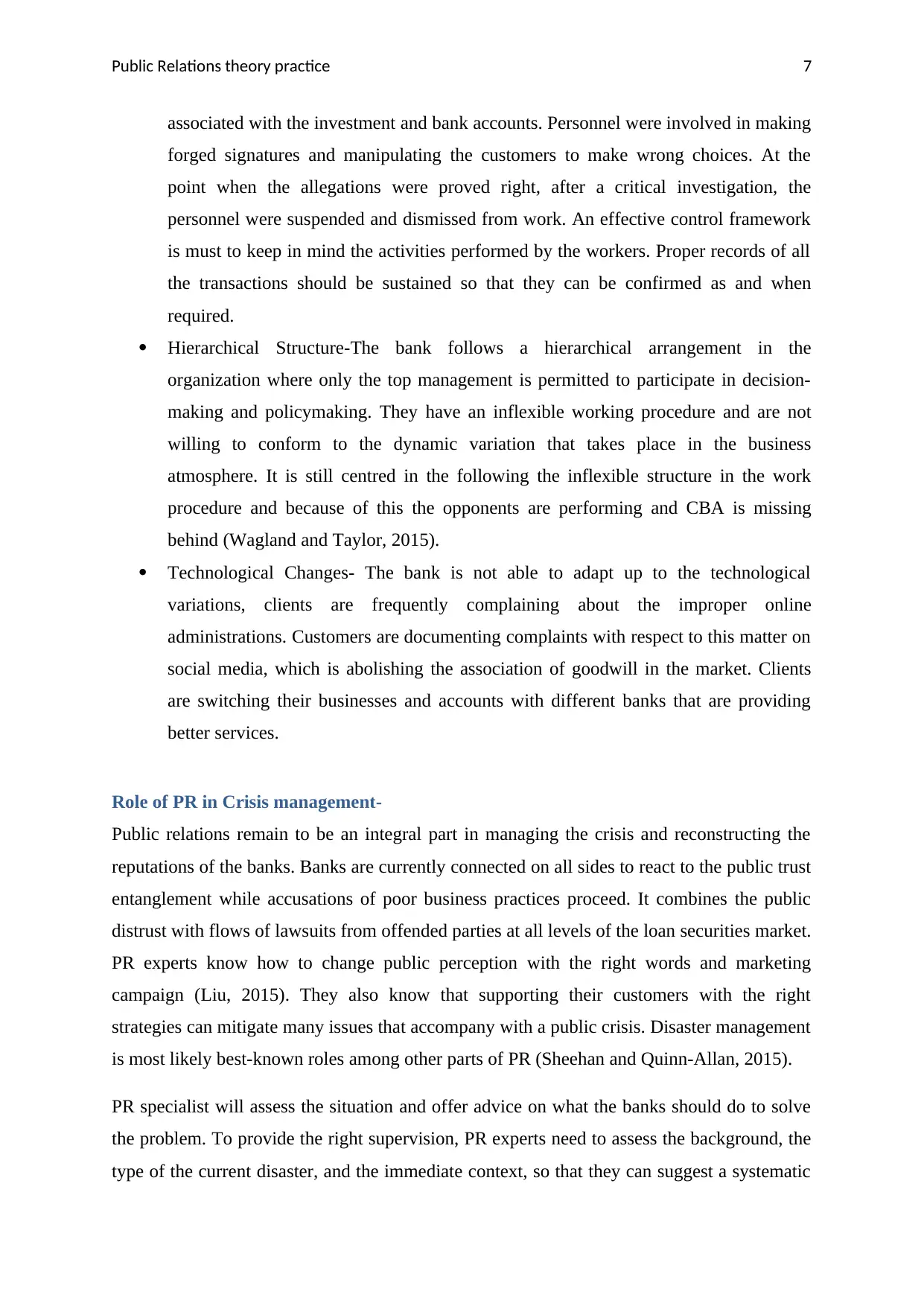
Public Relations theory practice 7
associated with the investment and bank accounts. Personnel were involved in making
forged signatures and manipulating the customers to make wrong choices. At the
point when the allegations were proved right, after a critical investigation, the
personnel were suspended and dismissed from work. An effective control framework
is must to keep in mind the activities performed by the workers. Proper records of all
the transactions should be sustained so that they can be confirmed as and when
required.
Hierarchical Structure-The bank follows a hierarchical arrangement in the
organization where only the top management is permitted to participate in decision-
making and policymaking. They have an inflexible working procedure and are not
willing to conform to the dynamic variation that takes place in the business
atmosphere. It is still centred in the following the inflexible structure in the work
procedure and because of this the opponents are performing and CBA is missing
behind (Wagland and Taylor, 2015).
Technological Changes- The bank is not able to adapt up to the technological
variations, clients are frequently complaining about the improper online
administrations. Customers are documenting complaints with respect to this matter on
social media, which is abolishing the association of goodwill in the market. Clients
are switching their businesses and accounts with different banks that are providing
better services.
Role of PR in Crisis management-
Public relations remain to be an integral part in managing the crisis and reconstructing the
reputations of the banks. Banks are currently connected on all sides to react to the public trust
entanglement while accusations of poor business practices proceed. It combines the public
distrust with flows of lawsuits from offended parties at all levels of the loan securities market.
PR experts know how to change public perception with the right words and marketing
campaign (Liu, 2015). They also know that supporting their customers with the right
strategies can mitigate many issues that accompany with a public crisis. Disaster management
is most likely best-known roles among other parts of PR (Sheehan and Quinn-Allan, 2015).
PR specialist will assess the situation and offer advice on what the banks should do to solve
the problem. To provide the right supervision, PR experts need to assess the background, the
type of the current disaster, and the immediate context, so that they can suggest a systematic
associated with the investment and bank accounts. Personnel were involved in making
forged signatures and manipulating the customers to make wrong choices. At the
point when the allegations were proved right, after a critical investigation, the
personnel were suspended and dismissed from work. An effective control framework
is must to keep in mind the activities performed by the workers. Proper records of all
the transactions should be sustained so that they can be confirmed as and when
required.
Hierarchical Structure-The bank follows a hierarchical arrangement in the
organization where only the top management is permitted to participate in decision-
making and policymaking. They have an inflexible working procedure and are not
willing to conform to the dynamic variation that takes place in the business
atmosphere. It is still centred in the following the inflexible structure in the work
procedure and because of this the opponents are performing and CBA is missing
behind (Wagland and Taylor, 2015).
Technological Changes- The bank is not able to adapt up to the technological
variations, clients are frequently complaining about the improper online
administrations. Customers are documenting complaints with respect to this matter on
social media, which is abolishing the association of goodwill in the market. Clients
are switching their businesses and accounts with different banks that are providing
better services.
Role of PR in Crisis management-
Public relations remain to be an integral part in managing the crisis and reconstructing the
reputations of the banks. Banks are currently connected on all sides to react to the public trust
entanglement while accusations of poor business practices proceed. It combines the public
distrust with flows of lawsuits from offended parties at all levels of the loan securities market.
PR experts know how to change public perception with the right words and marketing
campaign (Liu, 2015). They also know that supporting their customers with the right
strategies can mitigate many issues that accompany with a public crisis. Disaster management
is most likely best-known roles among other parts of PR (Sheehan and Quinn-Allan, 2015).
PR specialist will assess the situation and offer advice on what the banks should do to solve
the problem. To provide the right supervision, PR experts need to assess the background, the
type of the current disaster, and the immediate context, so that they can suggest a systematic
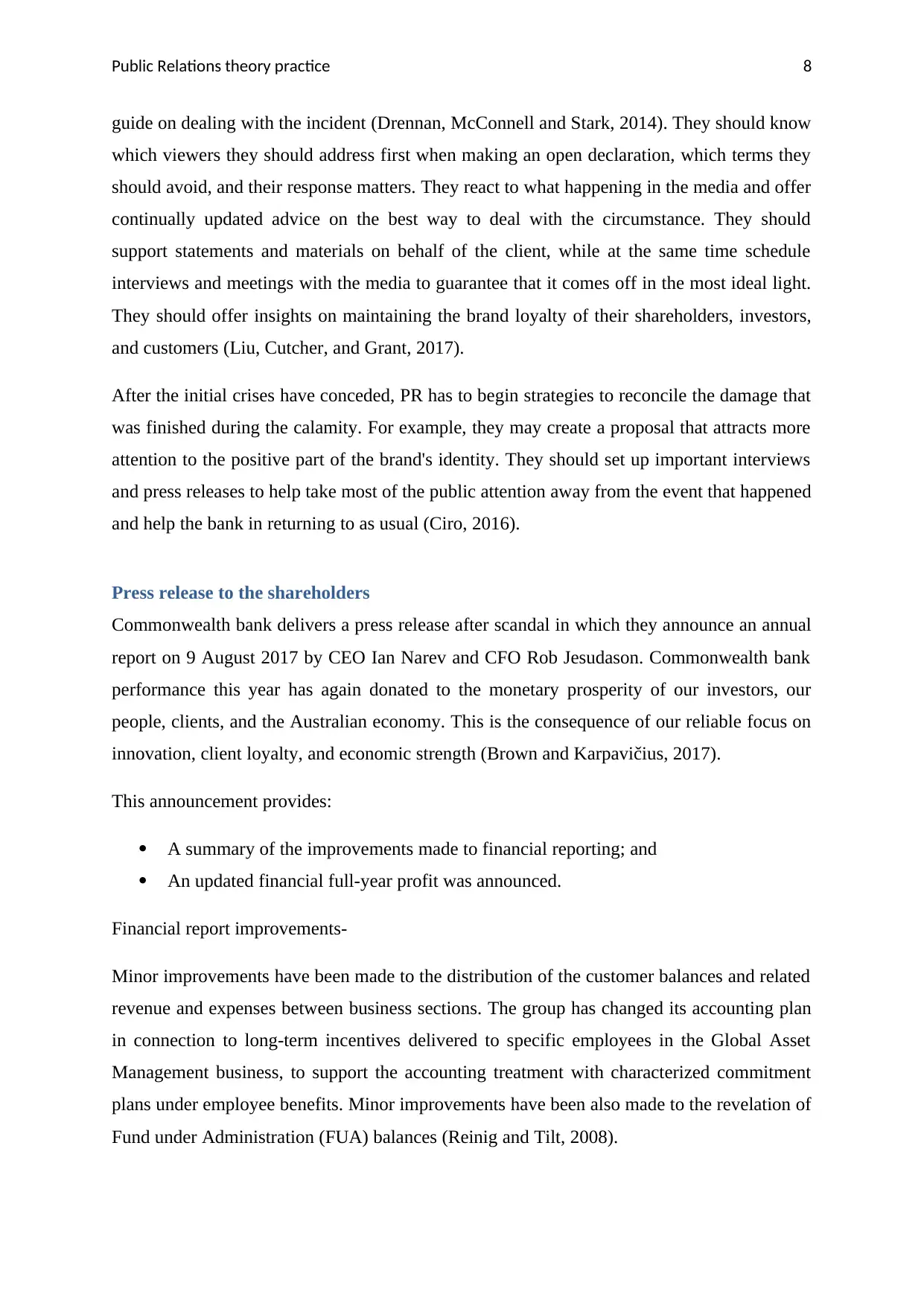
Public Relations theory practice 8
guide on dealing with the incident (Drennan, McConnell and Stark, 2014). They should know
which viewers they should address first when making an open declaration, which terms they
should avoid, and their response matters. They react to what happening in the media and offer
continually updated advice on the best way to deal with the circumstance. They should
support statements and materials on behalf of the client, while at the same time schedule
interviews and meetings with the media to guarantee that it comes off in the most ideal light.
They should offer insights on maintaining the brand loyalty of their shareholders, investors,
and customers (Liu, Cutcher, and Grant, 2017).
After the initial crises have conceded, PR has to begin strategies to reconcile the damage that
was finished during the calamity. For example, they may create a proposal that attracts more
attention to the positive part of the brand's identity. They should set up important interviews
and press releases to help take most of the public attention away from the event that happened
and help the bank in returning to as usual (Ciro, 2016).
Press release to the shareholders
Commonwealth bank delivers a press release after scandal in which they announce an annual
report on 9 August 2017 by CEO Ian Narev and CFO Rob Jesudason. Commonwealth bank
performance this year has again donated to the monetary prosperity of our investors, our
people, clients, and the Australian economy. This is the consequence of our reliable focus on
innovation, client loyalty, and economic strength (Brown and Karpavičius, 2017).
This announcement provides:
A summary of the improvements made to financial reporting; and
An updated financial full-year profit was announced.
Financial report improvements-
Minor improvements have been made to the distribution of the customer balances and related
revenue and expenses between business sections. The group has changed its accounting plan
in connection to long-term incentives delivered to specific employees in the Global Asset
Management business, to support the accounting treatment with characterized commitment
plans under employee benefits. Minor improvements have been also made to the revelation of
Fund under Administration (FUA) balances (Reinig and Tilt, 2008).
guide on dealing with the incident (Drennan, McConnell and Stark, 2014). They should know
which viewers they should address first when making an open declaration, which terms they
should avoid, and their response matters. They react to what happening in the media and offer
continually updated advice on the best way to deal with the circumstance. They should
support statements and materials on behalf of the client, while at the same time schedule
interviews and meetings with the media to guarantee that it comes off in the most ideal light.
They should offer insights on maintaining the brand loyalty of their shareholders, investors,
and customers (Liu, Cutcher, and Grant, 2017).
After the initial crises have conceded, PR has to begin strategies to reconcile the damage that
was finished during the calamity. For example, they may create a proposal that attracts more
attention to the positive part of the brand's identity. They should set up important interviews
and press releases to help take most of the public attention away from the event that happened
and help the bank in returning to as usual (Ciro, 2016).
Press release to the shareholders
Commonwealth bank delivers a press release after scandal in which they announce an annual
report on 9 August 2017 by CEO Ian Narev and CFO Rob Jesudason. Commonwealth bank
performance this year has again donated to the monetary prosperity of our investors, our
people, clients, and the Australian economy. This is the consequence of our reliable focus on
innovation, client loyalty, and economic strength (Brown and Karpavičius, 2017).
This announcement provides:
A summary of the improvements made to financial reporting; and
An updated financial full-year profit was announced.
Financial report improvements-
Minor improvements have been made to the distribution of the customer balances and related
revenue and expenses between business sections. The group has changed its accounting plan
in connection to long-term incentives delivered to specific employees in the Global Asset
Management business, to support the accounting treatment with characterized commitment
plans under employee benefits. Minor improvements have been also made to the revelation of
Fund under Administration (FUA) balances (Reinig and Tilt, 2008).
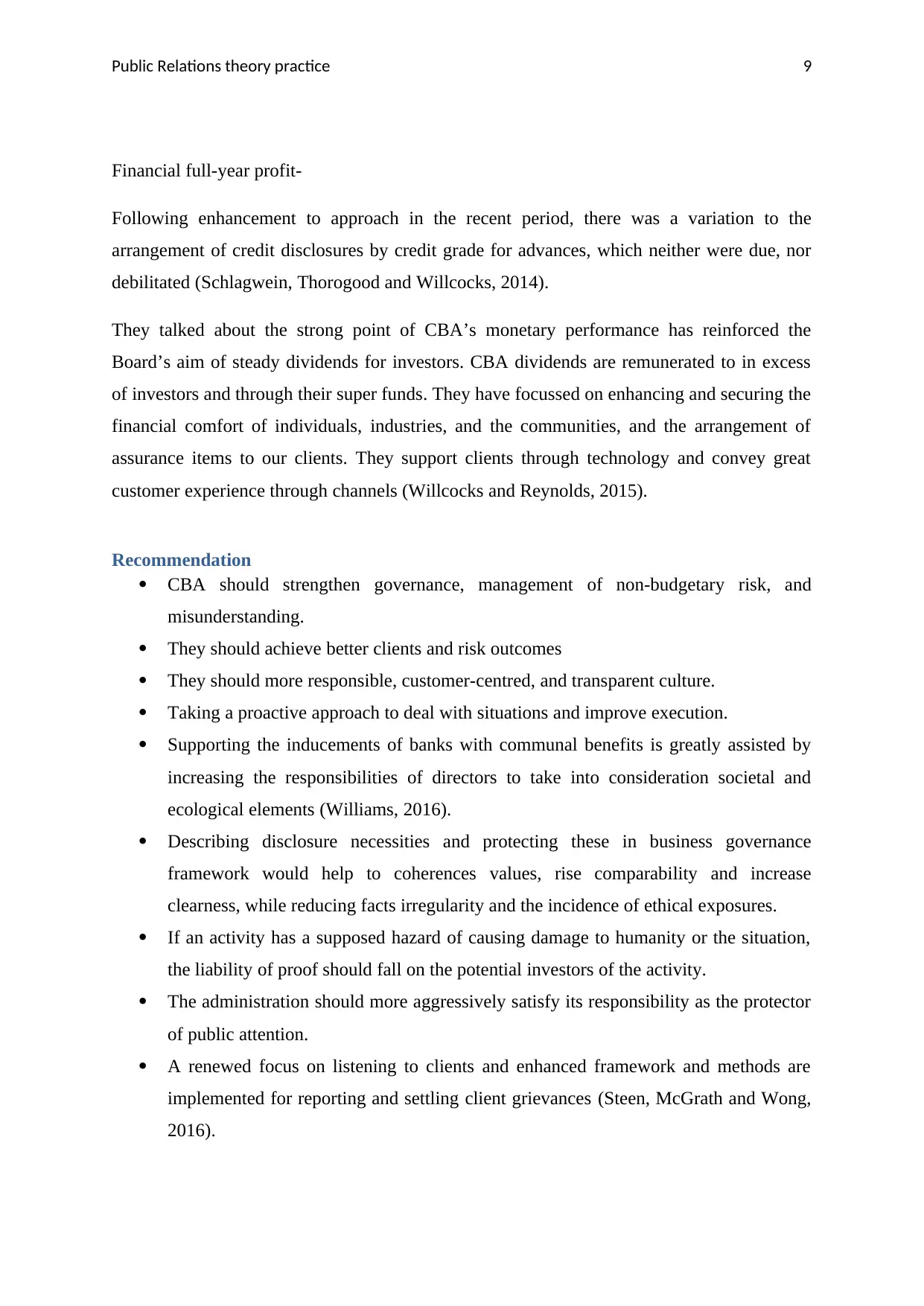
Public Relations theory practice 9
Financial full-year profit-
Following enhancement to approach in the recent period, there was a variation to the
arrangement of credit disclosures by credit grade for advances, which neither were due, nor
debilitated (Schlagwein, Thorogood and Willcocks, 2014).
They talked about the strong point of CBA’s monetary performance has reinforced the
Board’s aim of steady dividends for investors. CBA dividends are remunerated to in excess
of investors and through their super funds. They have focussed on enhancing and securing the
financial comfort of individuals, industries, and the communities, and the arrangement of
assurance items to our clients. They support clients through technology and convey great
customer experience through channels (Willcocks and Reynolds, 2015).
Recommendation
CBA should strengthen governance, management of non-budgetary risk, and
misunderstanding.
They should achieve better clients and risk outcomes
They should more responsible, customer-centred, and transparent culture.
Taking a proactive approach to deal with situations and improve execution.
Supporting the inducements of banks with communal benefits is greatly assisted by
increasing the responsibilities of directors to take into consideration societal and
ecological elements (Williams, 2016).
Describing disclosure necessities and protecting these in business governance
framework would help to coherences values, rise comparability and increase
clearness, while reducing facts irregularity and the incidence of ethical exposures.
If an activity has a supposed hazard of causing damage to humanity or the situation,
the liability of proof should fall on the potential investors of the activity.
The administration should more aggressively satisfy its responsibility as the protector
of public attention.
A renewed focus on listening to clients and enhanced framework and methods are
implemented for reporting and settling client grievances (Steen, McGrath and Wong,
2016).
Financial full-year profit-
Following enhancement to approach in the recent period, there was a variation to the
arrangement of credit disclosures by credit grade for advances, which neither were due, nor
debilitated (Schlagwein, Thorogood and Willcocks, 2014).
They talked about the strong point of CBA’s monetary performance has reinforced the
Board’s aim of steady dividends for investors. CBA dividends are remunerated to in excess
of investors and through their super funds. They have focussed on enhancing and securing the
financial comfort of individuals, industries, and the communities, and the arrangement of
assurance items to our clients. They support clients through technology and convey great
customer experience through channels (Willcocks and Reynolds, 2015).
Recommendation
CBA should strengthen governance, management of non-budgetary risk, and
misunderstanding.
They should achieve better clients and risk outcomes
They should more responsible, customer-centred, and transparent culture.
Taking a proactive approach to deal with situations and improve execution.
Supporting the inducements of banks with communal benefits is greatly assisted by
increasing the responsibilities of directors to take into consideration societal and
ecological elements (Williams, 2016).
Describing disclosure necessities and protecting these in business governance
framework would help to coherences values, rise comparability and increase
clearness, while reducing facts irregularity and the incidence of ethical exposures.
If an activity has a supposed hazard of causing damage to humanity or the situation,
the liability of proof should fall on the potential investors of the activity.
The administration should more aggressively satisfy its responsibility as the protector
of public attention.
A renewed focus on listening to clients and enhanced framework and methods are
implemented for reporting and settling client grievances (Steen, McGrath and Wong,
2016).
Secure Best Marks with AI Grader
Need help grading? Try our AI Grader for instant feedback on your assignments.
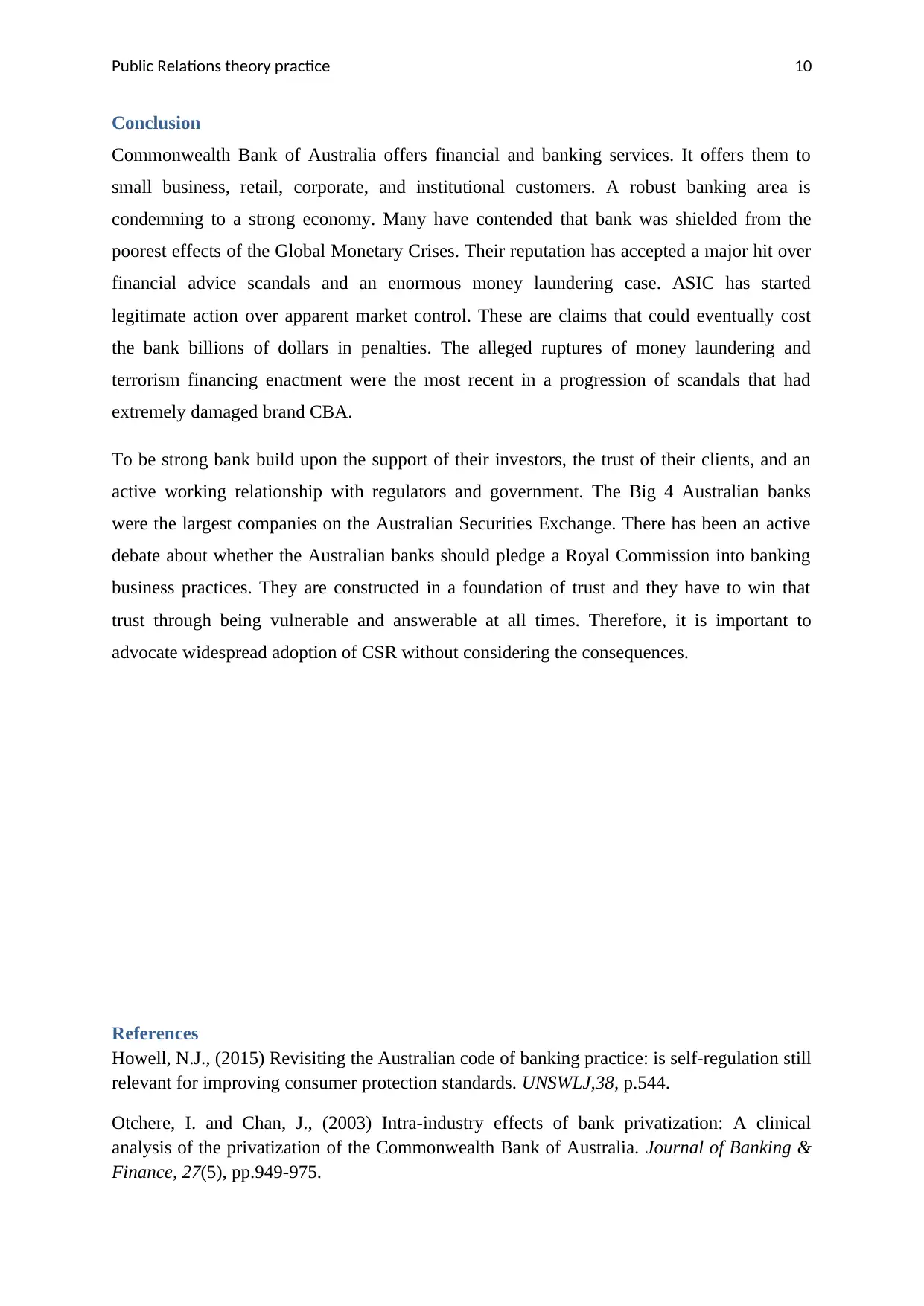
Public Relations theory practice 10
Conclusion
Commonwealth Bank of Australia offers financial and banking services. It offers them to
small business, retail, corporate, and institutional customers. A robust banking area is
condemning to a strong economy. Many have contended that bank was shielded from the
poorest effects of the Global Monetary Crises. Their reputation has accepted a major hit over
financial advice scandals and an enormous money laundering case. ASIC has started
legitimate action over apparent market control. These are claims that could eventually cost
the bank billions of dollars in penalties. The alleged ruptures of money laundering and
terrorism financing enactment were the most recent in a progression of scandals that had
extremely damaged brand CBA.
To be strong bank build upon the support of their investors, the trust of their clients, and an
active working relationship with regulators and government. The Big 4 Australian banks
were the largest companies on the Australian Securities Exchange. There has been an active
debate about whether the Australian banks should pledge a Royal Commission into banking
business practices. They are constructed in a foundation of trust and they have to win that
trust through being vulnerable and answerable at all times. Therefore, it is important to
advocate widespread adoption of CSR without considering the consequences.
References
Howell, N.J., (2015) Revisiting the Australian code of banking practice: is self-regulation still
relevant for improving consumer protection standards. UNSWLJ,38, p.544.
Otchere, I. and Chan, J., (2003) Intra-industry effects of bank privatization: A clinical
analysis of the privatization of the Commonwealth Bank of Australia. Journal of Banking &
Finance, 27(5), pp.949-975.
Conclusion
Commonwealth Bank of Australia offers financial and banking services. It offers them to
small business, retail, corporate, and institutional customers. A robust banking area is
condemning to a strong economy. Many have contended that bank was shielded from the
poorest effects of the Global Monetary Crises. Their reputation has accepted a major hit over
financial advice scandals and an enormous money laundering case. ASIC has started
legitimate action over apparent market control. These are claims that could eventually cost
the bank billions of dollars in penalties. The alleged ruptures of money laundering and
terrorism financing enactment were the most recent in a progression of scandals that had
extremely damaged brand CBA.
To be strong bank build upon the support of their investors, the trust of their clients, and an
active working relationship with regulators and government. The Big 4 Australian banks
were the largest companies on the Australian Securities Exchange. There has been an active
debate about whether the Australian banks should pledge a Royal Commission into banking
business practices. They are constructed in a foundation of trust and they have to win that
trust through being vulnerable and answerable at all times. Therefore, it is important to
advocate widespread adoption of CSR without considering the consequences.
References
Howell, N.J., (2015) Revisiting the Australian code of banking practice: is self-regulation still
relevant for improving consumer protection standards. UNSWLJ,38, p.544.
Otchere, I. and Chan, J., (2003) Intra-industry effects of bank privatization: A clinical
analysis of the privatization of the Commonwealth Bank of Australia. Journal of Banking &
Finance, 27(5), pp.949-975.

Public Relations theory practice 11
Sujan, A. and Abeysekera, I., (2007) Intellectual capital reporting practices of the top
Australian firms. Australian Accounting Review, 17(42), pp.71-83.
McIlroy, J., (2018) Bank scandals fuel calls for completely new system: Why we should
nationalise the big four under democratic control. Green Left Weekly, (1178), p.8.
Martin, N., Evans, M., Rice, J., Lodhia, S. and Gibbons, P., (2016) Using offsets to mitigate
environmental impacts of major projects: A stakeholder analysis. Journal of environmental
management, 179, pp.58-65.
Chan, M.C., Watson, J. and Woodliff, D., (2014) Corporate governance quality and CSR
disclosures. Journal of Business Ethics, 125(1), pp.59-73.
Moradi-Motlagh, A. and Babacan, A., (2015) The impact of the global financial crisis on the
efficiency of Australian banks. Economic Modelling, 46, pp.397-406.
Cummings, J.R. and Durrani, K.J., (2016) Effect of the Basel Accord capital requirements on
the loan-loss provisioning practices of Australian banks. Journal of Banking & Finance, 67,
pp.23-36.
Hamman, E., (2016) The influence of environmental NGOs on project finance: a case study
of activism, development and Australia’s Great Barrier Reef. Journal of Sustainable Finance
& Investment, 6(1), pp.51-66.
Wagland, S. and Taylor, S.M., (2015) The conflict between financial decision-making and
indigenous Australian culture. Financial Planning Research Journal, 1(1), pp.33-54.
Sheehan, M. and Quinn-Allan, D. eds., (2015) Crisis communication in a digital world.
Australia: Cambridge University Press.
Drennan, L.T., McConnell, A. and Stark, A., (2014) Risk and crisis management in the public
sector. London: Routledge.
Liu, H., Cutcher, L. and Grant, D., (2017) Authentic leadership in context: An analysis of
banking CEO narratives during the global financial crisis. Human Relations, 70(6), pp.694-
724.
Ciro, T., (2016) The global financial crisis: Triggers, responses and aftermath. London:
Routledge.
Brown, A. and Karpavičius, S., (2017) The Reaction of the Australian Stock Market to
Monetary Policy Announcements from the Reserve Bank of Australia. Economic
Record, 93(300), pp.20-41.
Reinig, C.J. and Tilt, C.A., (2008) Corporate social responsibility issues in media releases: a
stakeholder analysis of Australian banks. Issues in Social and Environmental
Accounting, 2(2), pp.176-197.
Sujan, A. and Abeysekera, I., (2007) Intellectual capital reporting practices of the top
Australian firms. Australian Accounting Review, 17(42), pp.71-83.
McIlroy, J., (2018) Bank scandals fuel calls for completely new system: Why we should
nationalise the big four under democratic control. Green Left Weekly, (1178), p.8.
Martin, N., Evans, M., Rice, J., Lodhia, S. and Gibbons, P., (2016) Using offsets to mitigate
environmental impacts of major projects: A stakeholder analysis. Journal of environmental
management, 179, pp.58-65.
Chan, M.C., Watson, J. and Woodliff, D., (2014) Corporate governance quality and CSR
disclosures. Journal of Business Ethics, 125(1), pp.59-73.
Moradi-Motlagh, A. and Babacan, A., (2015) The impact of the global financial crisis on the
efficiency of Australian banks. Economic Modelling, 46, pp.397-406.
Cummings, J.R. and Durrani, K.J., (2016) Effect of the Basel Accord capital requirements on
the loan-loss provisioning practices of Australian banks. Journal of Banking & Finance, 67,
pp.23-36.
Hamman, E., (2016) The influence of environmental NGOs on project finance: a case study
of activism, development and Australia’s Great Barrier Reef. Journal of Sustainable Finance
& Investment, 6(1), pp.51-66.
Wagland, S. and Taylor, S.M., (2015) The conflict between financial decision-making and
indigenous Australian culture. Financial Planning Research Journal, 1(1), pp.33-54.
Sheehan, M. and Quinn-Allan, D. eds., (2015) Crisis communication in a digital world.
Australia: Cambridge University Press.
Drennan, L.T., McConnell, A. and Stark, A., (2014) Risk and crisis management in the public
sector. London: Routledge.
Liu, H., Cutcher, L. and Grant, D., (2017) Authentic leadership in context: An analysis of
banking CEO narratives during the global financial crisis. Human Relations, 70(6), pp.694-
724.
Ciro, T., (2016) The global financial crisis: Triggers, responses and aftermath. London:
Routledge.
Brown, A. and Karpavičius, S., (2017) The Reaction of the Australian Stock Market to
Monetary Policy Announcements from the Reserve Bank of Australia. Economic
Record, 93(300), pp.20-41.
Reinig, C.J. and Tilt, C.A., (2008) Corporate social responsibility issues in media releases: a
stakeholder analysis of Australian banks. Issues in Social and Environmental
Accounting, 2(2), pp.176-197.
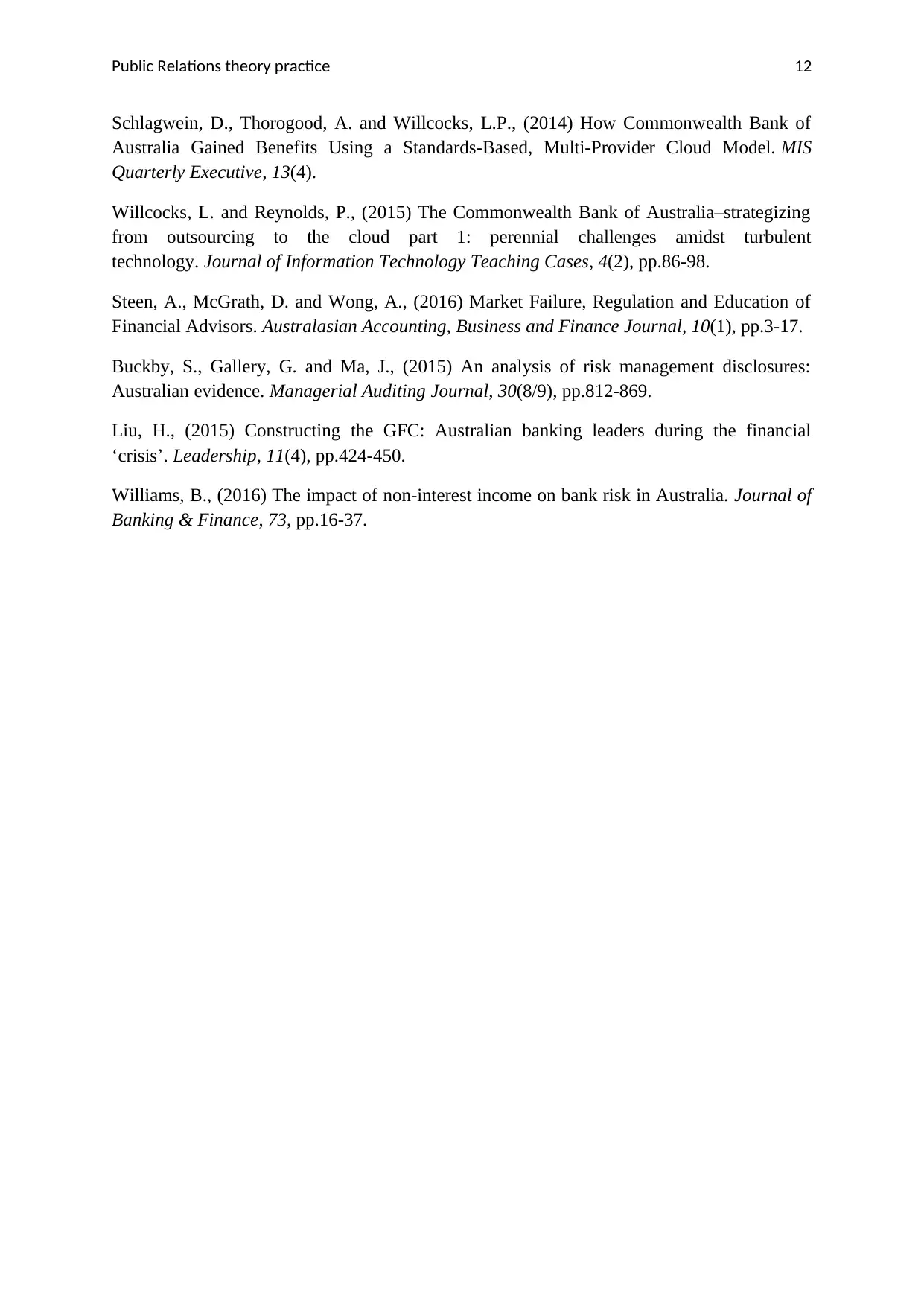
Public Relations theory practice 12
Schlagwein, D., Thorogood, A. and Willcocks, L.P., (2014) How Commonwealth Bank of
Australia Gained Benefits Using a Standards-Based, Multi-Provider Cloud Model. MIS
Quarterly Executive, 13(4).
Willcocks, L. and Reynolds, P., (2015) The Commonwealth Bank of Australia–strategizing
from outsourcing to the cloud part 1: perennial challenges amidst turbulent
technology. Journal of Information Technology Teaching Cases, 4(2), pp.86-98.
Steen, A., McGrath, D. and Wong, A., (2016) Market Failure, Regulation and Education of
Financial Advisors. Australasian Accounting, Business and Finance Journal, 10(1), pp.3-17.
Buckby, S., Gallery, G. and Ma, J., (2015) An analysis of risk management disclosures:
Australian evidence. Managerial Auditing Journal, 30(8/9), pp.812-869.
Liu, H., (2015) Constructing the GFC: Australian banking leaders during the financial
‘crisis’. Leadership, 11(4), pp.424-450.
Williams, B., (2016) The impact of non-interest income on bank risk in Australia. Journal of
Banking & Finance, 73, pp.16-37.
Schlagwein, D., Thorogood, A. and Willcocks, L.P., (2014) How Commonwealth Bank of
Australia Gained Benefits Using a Standards-Based, Multi-Provider Cloud Model. MIS
Quarterly Executive, 13(4).
Willcocks, L. and Reynolds, P., (2015) The Commonwealth Bank of Australia–strategizing
from outsourcing to the cloud part 1: perennial challenges amidst turbulent
technology. Journal of Information Technology Teaching Cases, 4(2), pp.86-98.
Steen, A., McGrath, D. and Wong, A., (2016) Market Failure, Regulation and Education of
Financial Advisors. Australasian Accounting, Business and Finance Journal, 10(1), pp.3-17.
Buckby, S., Gallery, G. and Ma, J., (2015) An analysis of risk management disclosures:
Australian evidence. Managerial Auditing Journal, 30(8/9), pp.812-869.
Liu, H., (2015) Constructing the GFC: Australian banking leaders during the financial
‘crisis’. Leadership, 11(4), pp.424-450.
Williams, B., (2016) The impact of non-interest income on bank risk in Australia. Journal of
Banking & Finance, 73, pp.16-37.
1 out of 13
Related Documents
Your All-in-One AI-Powered Toolkit for Academic Success.
+13062052269
info@desklib.com
Available 24*7 on WhatsApp / Email
![[object Object]](/_next/static/media/star-bottom.7253800d.svg)
Unlock your academic potential
© 2024 | Zucol Services PVT LTD | All rights reserved.




